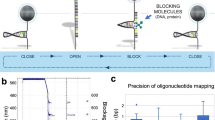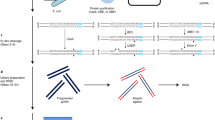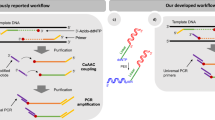Abstract
We have created double-stranded oligonucleotide arrays to perform highly parallel investigations of DNA–protein interactions. Arrays of single-stranded DNA oligonucleotides, synthesized by a combination of photolithography and solid-state chemistry, have been used for a variety of applications, including large-scale mRNA expression monitoring, genotyping, and sequence-variation analysis. We converted a single-stranded to a double-stranded array by synthesizing a constant sequence at every position on an array and then annealing and enzymatically extending a complementary primer. The efficiency of second-strand synthesis was demonstrated by incorporation of fluorescently labeled dNTPs (2´-deoxyribonucleoside 5´-triphosphates) and by terminal transferase addition of a fluorescently labeled ddNTP. The accuracy of second-strand synthesis was demonstrated by digestion of the arrayed double-stranded DNA (dsDNA) on the array with sequence-specific restriction enzymes. We showed dam methylation of dsDNA arrays by digestion with DpnI, which cleaves when its recognition site is methylated. This digestion demonstrated that the dsDNA arrays can be further biochemically modified and that the DNA is accessible for interaction with DNA-binding proteins. This dsDNA array approach could be extended to explore the spectrum of sequence-specific protein binding sites in genomes.
This is a preview of subscription content, access via your institution
Access options
Subscribe to this journal
Receive 12 print issues and online access
$209.00 per year
only $17.42 per issue
Buy this article
- Purchase on Springer Link
- Instant access to full article PDF
Prices may be subject to local taxes which are calculated during checkout





Similar content being viewed by others
References
Pabo, C.O. & Sauer, R.T. Transcription factors: structural families and principles of DNA recognition. Annu. Rev. Biochem. 61, 1053–1095 ( 1992).
Craig, N.L. The mechanism of conservative site-specific recombination. Annu. Rev. Genet. 22, 77–105 ( 1988).
Pingoud, A. & Jeltsch, A. Recognition and cleavage of DNA by type-II restriction endonucleases. Eur. J. Biochem. 246, 1–22 (1997).
Margulies, C. & Kaguni, J.M. Ordered and sequential binding of DNA protein to oriC, the chromosomal origin of Escherichia coli. J. Biol. Chem. 271, 17035–17040 (1996).
Woodbury, C.P. & Hippel, P.H.V. On the determination of deoxyribonucleic acid–protein interaction parameters using the nitrocellulose filter-binding assay. Biochemistry 22, 4730– 4737 (1983).
Jansen, C., Gronenborn, A.M. & Clore, G.M. The binding of the cyclic AMP receptor protein to synthetic DNA sites containing permutations in the consensus sequence TGTGA. Biochem. J. 246, 227–232 (1987).
Bowen, B., Steinberg, J., Laemmli, U.K. & Weintraub, H. The detection of DNA-binding proteins by protein blotting. Nucleic Acids Res. 8, 1–20 ( 1980).
Miskimins, W.K., Roberts, M.P., McClelland, A. & Ruddle, F.H. Use of a protein-blotting procedure and a specific DNA probe to identify nuclear proteins that recognize the promoter region of the transferrin receptor gene. Proc. Natl. Acad. Sci. USA 82, 6741– 6744 (1985).
Hanes, S.D. & Brent, R. A genetic model for interaction of the homeodomain recognition helix with DNA. Science 251, 426–430 (1991).
Lockhart, D.J. et al. Expression monitoring by hybridization to high-density oligonucleotide arrays. Nat. Biotechnol. 14, 1675– 1680 (1996).
Roth, F.P., Hughes, J.D., Estep, P.W. & Church, G.M. Finding DNA regulatory motifs within unaligned noncoding sequences clustered by whole-genome mRNA quantitation. Nat. Biotechnol. 16, 939–945 (1998).
Schena, M., Shalon, D., Davis, R.W. & Brown, P.O. Quantitative monitoring of gene expression patterns with a complementary DNA microarray. Science 270, 467–470 ( 1995).
Chee, M. et al. Accessing genetic information with high-density DNA arrays. Science 274, 610–614 ( 1996).
Gunderson, K.L. et al. Mutation detection by ligation to complete N-mer DNA arrays. Genome Res. 8, 1142–1153 (1998).
Hacia, J.G., Brody, L.C., Chee, M.S., Fodor, S.P.A. & Collins, F.S. Detection of heterozygous mutations in BRCA1 using high density oligonucleotide arrays and two-colour fluorescence analysis. Nat.Genet. 14, 441–447 (1996).
Wang, D.G. et al. Large-scale identification, mapping, and genotyping of single-nucleotide polymorphisms in the human genome. Science 280, 1077– 1082 (1998).
Shoemaker, D.D., Lashkari, D.A., Morris, D., Mittmann, M. & Davis, R.W. Quantitative phenotypic analysis of yeast deletion mutants using a highly parallel molecular bar-coding strategy. Nat. Genet. 14, 450–456 (1996).
Cho, R.J. et al. Parallel analysis of genetic selections using whole genome oligonucleotide arrays. Proc. Natl. Acad. Sci. USA 95, 3752 –3757 (1998).
Lockhart, D.J., Vetter, D. & Diggelmann, M. Surface-bound, unimolecular, double-stranded DNA. (Affymetrix, Inc., USA). US patent # 5556752, issue date 9/17/96.
Pease, A.C. et al. Light-generated oligonucleotide arrays for rapid DNA sequence analysis. Proc. Natl. Acad. Sci. USA 91, 5022– 5026 (1994).
McGall, G.H. et al. The efficiency of light-directed synthesis of DNA arrays on glass substrates. J. Amer. Chem. Soc. 119, 5081 –5090 (1997).
Polisky, B. et al. Specificity of substrate recognition by the EcoRI restriction endonuclease. Proc. Natl. Acad. Sci. USA 72, 3310–3314 (1975).
Thielking, V., Alves, J., Fliess, A., Maass, G. & Pingoud, A. Accuracy of the EcoRI restriction endonuclease: binding and cleavage studies with oligodeoxynucleotide substrates containing degenerate recognition sequences. Biochemistry 29, 4682–4691 (1990).
Engler, L.E., Welch, K.K. & Jen-Jacobson, L. Specific binding by EcoRV endonuclease to its DNA recognition site GATATC. J. Mol. Biol. 269, 82–101 (1997).
Lesser, D.R., Kurpiewski, M.R. & Jen-Jacobson, L. The energetic basis of specificity in the EcoRI endonuclease–DNA interaction. Science 250, 776–786 (1990).
McClarin, J.A. et al. Structure of the DNA–EcoRI endonuclease recognition complex at 3 A resolution. Science 234, 1526–1541 (1986).
Wah, D.A., Hirsch, J.A., Dorner, L.F., Schildkraut, I. & Aggarwal, A.K. Structure of the multimodular endonuclease FokI bound to DNA. Nature 388, 97–100 (1997).
Winkler, F.K. et al. The crystal structure of EcoRV endonuclease and of its complexes with cognate and non-cognate DNA fragments. EMBO J. 12, 1781–1795 (1993).
Newman, M., Strzelecka, T., Dorner, L.F., Schildkraut, I. & Aggarwal, A.K. Structure of BamHI endonuclease bound to DNA: partial folding and unfolding on DNA binding. Science 269, 656–663 ( 1995).
Cheng, X., Balendiran, K., Schildkraut, I. & Anderson, J.E. Structure of PvuII endonuclease with cognate DNA. EMBO J. 13, 3927–3935 ( 1994).
Newman, M. et al. Crystal structure of restriction endonuclease BglI bound to its interrupted DNA recognition sequence. EMBO J. 17,5466–5476 (1998).
Terry, B.J., Jack, W.E., Rubin, R.A. & Modrich, P. Thermodynamic parameters governing interaction of EcoRI endonuclease with specific and nonspecific DNA sequences. J. Biol. Chem. 258, 9820–9825 (1983).
Kuz'min, N.P., Loseva, S.P., Beliaeva, R.K., Kravets, A.N. & Solonin, A.S. EcoRV restrictase: physical and catalytic properties of homogenous enzyme. Mol. Biol. (Mosk) 18, 197–204 (1984).
George, J., Blakesley, R.W. & Chirikjian, J.G. Sequence-specific endonuclease BamHI. Effect of hydrophobic reagents on sequence recognition and catalysis. J. Biol. Chem. 255, 6521–6524 (1980).
Nasri, M. & Thomas, D. Alteration of the specificity of PvuII restriction endonuclease. Nucleic Acids Res. 15, 7677–7687 (1987).
Escherichia coli and salmonella. Cellular and molecular biology Vol. 1. (ed. Neidhardt, F.C.) (ASM, Washington, DC; 1996).
Swartz, D.R. Covalent labeling of proteins with fluorescent compounds for imaging applications. Scanning Microsc. Suppl. 10, 273– 284 (1996).
Kim, Y.-G., Cha, J. & Chandrasegaran, S. Hybrid restriction enzymes: zinc finger fusions to FokI cleavage domain. Proc. Natl. Acad. Sci. USA 93, 1156–1160 (1996).
Panayotatos, N. & Backman, S. A site-directed recombinant nuclease probe of DNA structure. J. Biol. Chem. 264, 15070–15073 (1989).
Tavazoie, S. & Church, G.M. Quantitative whole-genome analysis of DNA–protein interactions by in vivo methylase protection in E. coli. Nat. Biotechnol. 16, 566– 571 (1998).
Robison, K., McGuire, A.M. & Church, G.M. A comprehensive library of DNA-binding site matrices for 55 proteins applied to the complete Escherichia coli K-12 genome. J. Mol. Biol. 284, 241– 254 (1998).
Desjarlais, J.R. & Berg, J.M. Length-encoded multiplex binding site determination: application to zinc finger proteins. Proc. Natl. Acad. Sci. USA 91, 11099– 11103 (1994).
Harrison, S.C. & Aggarwal, A.K. DNA recognition by proteins with the helix-turn-helix motif. Annu. Rev. Biochem. 59, 933–969 ( 1990).
Suzuki, M., Yagi, N. & Gerstein, M. DNA recognition and superstructure formation by helix-turn-helix proteins. Protein Eng. 8, 329– 338 (1995).
Harrison, S.C. A structural taxonomy of DNA-binding domains. Nature 353, 715–719 (1991).
Liu-Johnson, H.-N., Garterberg, M.R. & Crothers, D.M. The DNA binding domain and bending angle of E. coli CAP protein. Cell 47, 995– 1005 (1986).
Wodicka, L., Dong, H., Mittmann, M., Ho, M.-H. & Lockhart, D.J. Genome-wide expression monitoring in Saccharomyces cerevisiae. Nat. Biotechnol. 15, 1359 –1366 (1997).
Molecular probes: handbook of fluorescent probes and research chemicals. (ed. Haugland, R.P.) (Molecular Probes, Inc., Eugene, Oregon, 1996).
Acknowledgements
We thank John Aach and Keith Robison for help with Perl. We also thank Mark Chee, Rich Baldarelli, as well as members of the Church lab for helpful discussions and critical reading of the manuscript. This work was supported by the US Department of Energy (grant no. DE-FG02-87-ER60565). M.B. was supported by an NSF Graduate Fellowship. G.M.C. was partially supported by the Howard Hughes Medical Institute. This article is dedicated to my father, Roman P. Bulyk, who passed away while this work was being completed.
Author information
Authors and Affiliations
Corresponding author
Rights and permissions
About this article
Cite this article
Bulyk, M., Gentalen, E., Lockhart, D. et al. Quantifying DNA–protein interactions by double-stranded DNA arrays . Nat Biotechnol 17, 573–577 (1999). https://doi.org/10.1038/9878
Received:
Accepted:
Issue Date:
DOI: https://doi.org/10.1038/9878
This article is cited by
-
Express photolithographic DNA microarray synthesis with optimized chemistry and high-efficiency photolabile groups
Journal of Nanobiotechnology (2016)
-
New Technologies Provide Quantum Changes in the Scale, Speed, and Success of SELEX Methods and Aptamer Characterization
Molecular Therapy - Nucleic Acids (2014)
-
DNA-protein interactions in high definition
Genome Biology (2012)
-
Inferring gene regulatory logic from high-throughput measurements of thousands of systematically designed promoters
Nature Biotechnology (2012)
-
DNA–protein interactions: methods for detection and analysis
Molecular and Cellular Biochemistry (2012)



